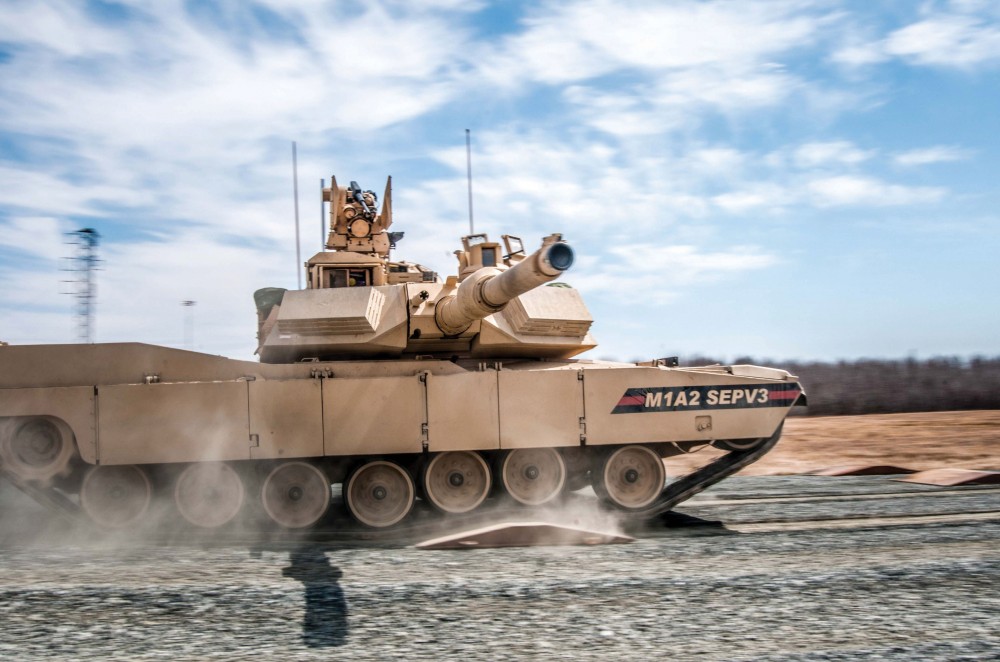The Army’s New Tank Fires ‘Smart’ Cannon Rounds

Credit to Author: David Axe| Date: Mon, 09 Oct 2017 19:30:00 +0000
The US Army just got a new tank with the ability to fire deadlier “smart” rounds from its powerful, 120-millimeter-diameter main cannon.
The new fighting vehicle’s unwieldy designation obscures its technological advancements. Officially, the new M-1A2 Systems Enhancement Package Version 3 tank, or M-1A2SEPV3, is a mere upgrade of the Army’s previous main battle tank, the M-1A2SEPV2 that entered service in 2007.
In fact, the tank boasts stronger armor, better electronics, and more efficient propulsion and power systems than on previous tanks, making it, in effect, a brand-new vehicle.
“Principal improvements are in lethality, survivability and sustainability,” Don Kotchman, a vice president at General Dynamics Land Systems, which builds the M-1, told Jane’s. The Army asked Congress to fund 56 V3 tanks for around $20 million apiece in 2018, according to budget documents.
The V3 introduces an important new weapon to the Army’s arsenal. The new tank is the first in the ground combat branch’s inventory to come with a digital datalink that makes it compatible with the Army’s Advanced Multi-Purpose (AMP) smart cannon round.
The roughly 50-pound AMP round instantly reconfigures itself depending on the target the vehicle crew is aiming at—adjusting its fuse for, say, piercing an enemy tank’s own armor, punching through a wall, hitting a helicopter in mid-flight, or raining down lethal fragments on soldiers hiding in a foxhole.
In so doing, the new round replaces at least four existing rounds—each purpose-built for a specific target. Instead of spending seconds rooting around for the right round, the loader on an M-1-A2SEPV3’s four-person crew can just grab one of the smart rounds.
“Having one round for multiple targets saves critical time for soldiers in combat since they will always have an effective round for whatever target they identify,” Lt. Col. Kyle McFarland, then overseeing tank-ammo development for the Army, said in 2016.
Once the loader has shoved the round into the cannon’s breach, the crew taps a command into the V3 tank’s computer—and the tank instantly tells the shell how it needs to explode. Old-style rounds had to be configured manually. “This ability to shave seconds off the first effective engagement can mean the difference between life and death,” McFarland said.
Read more: The Army’s Futuristic Guard Posts Are Trailers with Pop-Up Gun Turrets
It’s more important than ever for the Army to hang on to every possible technological advantage. America’s main rivals are developing and fielding their own advanced tanks, some boasting technologies that even the M-1A2SEPV3 lacks.
Russia’s new Armata tank, which is still in development, boasts a three-person crew and a highly-automated, unmanned turret that the Russian government claims is superior to the M-1 with its four crew and traditional, manned turret. “The technical means of automatic target-tracking and identification greatly exceeds the human capability,” an unnamed tank expert told Russia’s government-owned Sputnik website.
Some Russian tanks can fire guided missiles from their main guns. China’s own new Type 99A tank can apparently also fire missiles, which can help to compensate for the relative inaccuracy of the vehicle’s computerized cannon-aiming system.
If there’s a downside to the new American tank’s smart cannon round, it’s cost. “If you were to compare the cost of a single AMP round to one of the single rounds it replaces, the AMP is going to cost more,” McFarland said. In February, the Army paid ammo-maker Orbital ATK $45 million to complete development of the new smart round.
Get six of our favorite Motherboard stories every day by signing up for our newsletter.